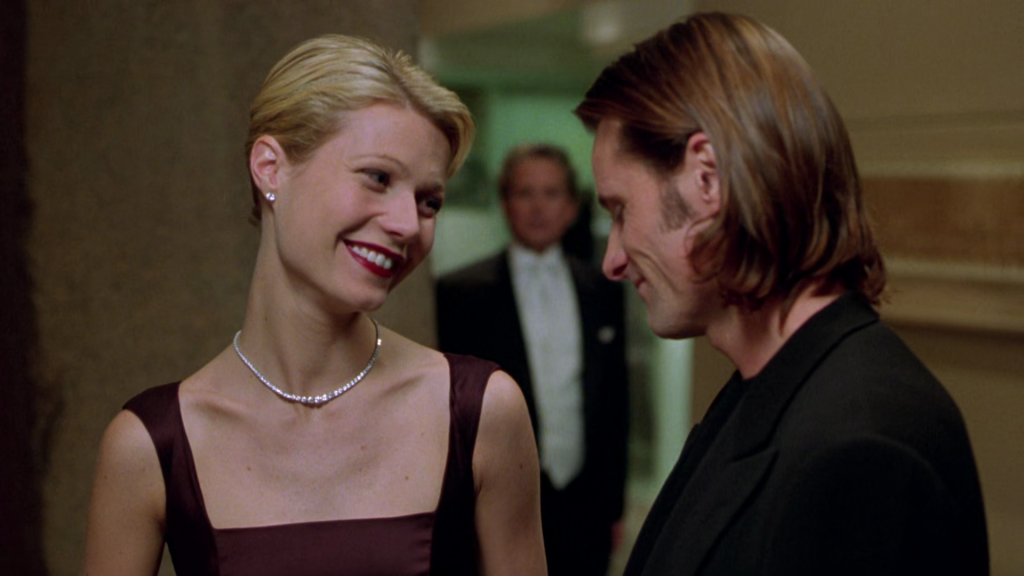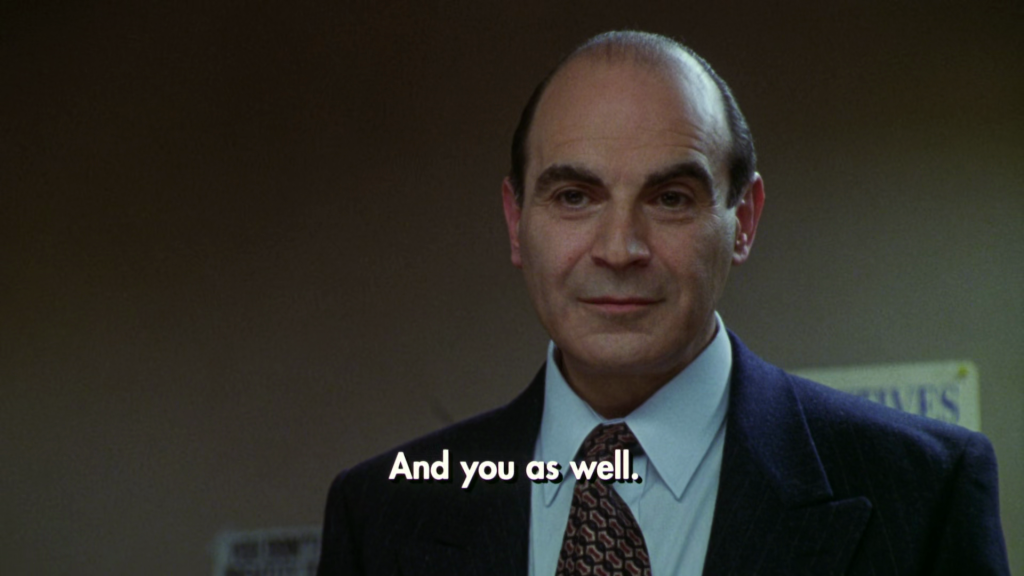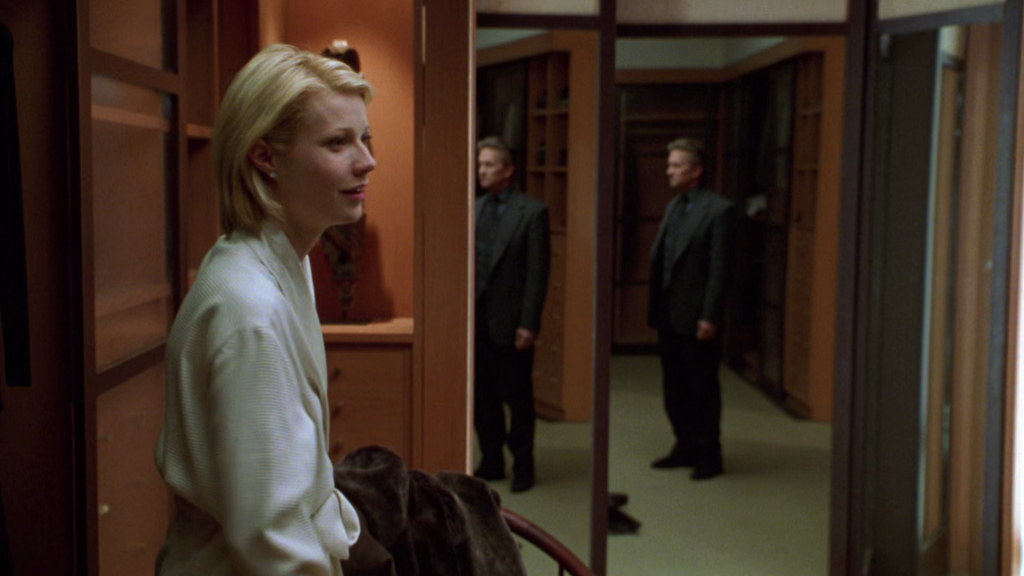
A Perfect Murder (Andrew Davis, 1998) is a remake of Hitchcock’s Dial M for Murder (1954). This almost anonymous thriller stars Michael Douglas, Gwyneth Paltrow and Viggo Mortensen. Although it was released in the same year as the homonymous remake of Psycho (1960), its premises and terms could not be further from Gus Van Sant’s project. Hitchcockian films such as The Perfect Murder, Arlington Road (1999), What Lies Beneath (2000) or Flightplan (2005) – to restrict myself to the period in question – make us think of the “anonymous machines” whose operation the critic Nicolas Saada glimpsed in the James Bond series: films without identity that produce “an astonishing number of cinema ideas, without signature effect, without the shadow of a ‘personality’ in charge”. We are far, in this case, from the authorial exhibitionism of other Hitchcockians such as De Palma, Verhoeven or Fincher.
The narrative of A Perfect Murder, substantially different from Dial M for Murder, maintains, however, a basic structure: that of the husband who plans the murder of his wife after discovering that she is cheating on him with another man. Among the changes made in relation to the original film, the most sensitive is the one that concerns the lover. If in Hitchcock’s film he played the role of an investigator who put together the pieces of the puzzle and saved the character of Grace Kelly from the death penalty (he was, there, a writer of detective stories), here he is the vector itself who, blackmailed by the protagonist’s husband, must carry out the woman’s murder. Thus, the husband Steven (Michael Douglas) forms a pact with the lover David (Viggo Mortensen), who is tasked with killing Emily (Gwyneth Paltrow).

The displacement is not that simple. The lover in Hitchcock’s film, played by Robert Cummings, was a successful writer. The hired killer, played by Anthony Swann, was a trickster who seduced rich women to steal their money. In A Perfect Murder, Mortensen’s character amalgamates these two: he is both lover and impostor. It is with this information in hand – that he is a scammer – that Steven, the husband, blackmails David. More than a moral opposition, what separates the two characters is, more fundamentally, social class. A Perfect Crime, unlike its precursor, makes extensive use of exteriors (Dial M for Murder, adapted from a play, worked with theatrical codes and used an apartment as the main location). It is these exteriors that allow the film to solidify the opposition between the main couple’s luxury apartment – Steven is a Wall Street investor and Emily, an heiress – and the lover’s studio, who works as a painter in the working-class neighborhood of Brooklyn.
The lowering of the lover’s social class has more and less obvious consequences. On the one hand, Emily seems to project onto her lover nothing more than the possibility of satisfying a perverse desire or alleviating a certain bad elite conscience. Both the shots of her character on the subway, on the way to the studio, and the gift she gives David in the sequence (a coffee maker that, in her words, brings “a little civilization” to the space) testify to this bad conscience at once parasitic and narcissistic (“David is only interested in painting and me”, Emily confides to a friend at the beginning of the film). On his husband’s side, Steven also instrumentalizes the poor lover, blackmailing him into committing his wife’s murder. The film seems to insinuate, at first, that the popular classes are directly affected by the marital crises of the rich – which does not mean to exonerate David.
However, we have not yet scratched the surface of the essential aspects of changing the lover’s status. To begin to surround it, it is necessary to scrutinize the terms of the marital crisis. In Dial M for Murder, the husband played by Ray Milland acted out of revenge (for adultery) and greed (for his wife’s inheritance). Steven acts for the same reasons, but in addition to them is an unavoidable reason: while we did not find, in Hitchcock’s film, an element that pointed to a financial crisis for her husband, here it is made clear that Steven’s business on Wall Street is in decline. We could conclude, pragmatically, that the husband’s economic collapse is a decisive factor in his decision to murder his heiress wife (it is an attempt to recover the lost money), but the film suggests that the relationship between the two crises – financial and marital – are more nuanced.

At the beginning of the film, a parallel montage alternates between two spaces and two situations: Steven in his office, dealing with the collapse of his economic empire, and Emily and David in the studio, having sex among works of art. If the convergence between the two tension poles is characteristic of parallel montage, the same is true here. At the end of the sequence, Steven calls the studio and leaves a message on the answering machine, which is heard by the lovers in bed (I will return to this triangular configuration). Echoing one another, the parallel scenes begin to define the contours of Steven’s crisis – the real crisis. Behaving like a perfect specimen of the Hitchcockian lineage, the husband played by Michael Douglas reacts to the ruin of his masculine role in the patriarchal order.
Tania Modleski’s words about Vertigo – a film that consists of “the chronicle of Scottie’s difficulties in reaffirming a virility lost in the wake of his failure as a representative of the law” – accurately describe the series of Hitchcockian characters haunted by the specter of female castration. Steven belongs to this series, and his plan from the beginning of the film responds to the attempt to regain his place in the patriarchy, that is, to regain a minimum simulacrum of control in the symbolic order. That the character is played by Michael Douglas, who in the 1980s and 1990s constantly played this role – in films such as Fatal Attraction (1987), Basic Instinct (1992), Disclosure (1994) or even The Game (1997) – It’s not just any detail. A Perfect Crime seems like a logical continuity in the actor’s filmography: here, it is an attempt to recover a symbolic masculine position that is continuously threatened by women.
The justifications for Steven’s crisis are traceable. If the parallel montage mentioned above is a fundamental moment in the film, it is because it explains the relationship between marital and economic decline. For Steven doesn’t just resent being betrayed – he more deeply resents the fall from his symbolic position as provider. If he devises a plan to murder his wife, it is not so much because she is just having sex with another man, but because the economic recession of his business would lead him to be supported by his wife. It is preferable for the male character to plan the murder of his wife to acquire the inheritance than to assume the role – historically female – of a figure supported financially by his spouse. David, in this sense, is like a mirror of the emasculated Steven, the ghost of a future, because what the husband seems to glimpse in the lover, ultimately, is his destiny as a poor man enjoying the rich woman’s money.

The resumption of Steven’s symbolic position is not an operation restricted to murder. Throughout the narrative, the film distills small gestures that proclaim this perverse work of recovering a simulacrum of dominance. The dress that the husband chooses for his wife, the small traps planted, the recurring surprises and scares, among others, are related to this attempt to simultaneously undermine the wife’s control and regain an illusion of power. Among these strategies, gaslighting stands out most prominently, which serves the agenda of confusing, disorienting and manipulating women. If gaslighting is a violent interruption of a woman’s access to language (the words are by Hélène Frappat), we begin to understand the film’s insistence on ambiguous dialogue and double-entendre games. In many cases, the immediate meaning of a speech is fully accessed by the characters, but behind it lies a hidden meaning (or rather a polysemy) that is restricted to the men. When Steven tells Emily, for example, that he visited the painter’s studio and “made him an offer”, his wife assumes he is talking about a painting. The offer, as we know, concerned her murder.
Keeping women apart from the polysemic content of language becomes, for men, a tool to control them. In the second half of the film, we see Emily return certain lines of dialogue to Steven, reversing their meaning and confronting him with his own words. The dynamic is similar to the ending of Gaslight (1944), by George Cukor, where Ingrid Bergman refused to release her husband – who during the narrative wanted to make her believe she was crazy – under the excuse that she had “gone mad”. Emily’s stance towards her husband resonates with the character’s growth in the narrative: it is at this moment that she begins to follow the money, to take on the role of investigator.
In Dial M for Murder, this position was occupied by the inspector played by John Williams. Here, the role of the detective (David Suchet) is different: in the language drama staged by the film, he is the only one who manages to establish a connection with the victim, using a secret, private, restricted language. Emily, who works as a diplomat, knows how to speak the language of the detective of Arabic descent. The first exchange of words in another language – a sympathetic dialogue about the detective’s family – takes place in the interrogation room, where Steven, sitting next to Emily, insists on answering the questions for her. The lines insistently crafted by the husband are contrasted, in the symbolic field, with the intimate conversation between Emily and the detective, inaccessible to the other participants in the interrogation. This initial connection is fundamental, as from now on it will be the woman who will take the reins of the investigation.

The film cannot, however, allow the female character to fully enjoy her agency. There is something disturbing about the scene in which Emily, apparently aware of the fact that Steven was responsible for the plan that almost killed her, confronts her husband in his Wall Street office. The beginning of the scene follows the logic of ironic inversions: instead of being surprised by Steven, it is Emily who surprises the male character; Instead of being kept apart from the polysemy of language, she returns, against her husband, lines of dialogue that he had already used in the narrative. We see the seed of subversion germinate. What follows, however, is the regression of the female character to her initial position: Steven returns to manipulating her and stripping her of her power, this time appealing to Emily’s guilt regarding adultery. The woman is not granted the right to unmask her tormentor: it would be more reasonable, given the misogyny that presides over the narrative, for the discovery of the crime to take place in a later scene, which emphasizes not the fairness of the female perception, but the male error. After murdering David, Steven returns to the house taking with him a shoebox of money and an incriminating recording. He keeps the money and the recording in the safe, but makes the mistake of leaving the shoebox visible.
The outcome is not entirely devoid of interest. While her husband is in the shower, Emily notices the empty box and intuits that its old contents are deposited in the safe – to which she knows the combination. Here, the film mirrors a previous scene, in which Steven had surprised his wife at lunch. Knowing that she had an appointment with David, and that she would try to find ways to call her lover to let him know about the surprise lunch with her husband, Steven leaves his cell phone on the restaurant table while he goes to another table to greet some friends. The scene set up by Steven becomes a kind of trap, a gaslighting cipher. Emily’s look towards her cell phone, the impulse – not carried out – to pick it up, resonates in the character’s look towards the shoe box. This time, giving in to the impulse means accessing the truth.
There is yet another mirroring of interest. I described, above, the parallel montage that opposed Steven in the office and the lovers in the studio. There, Steven’s voice invaded the lovers’ space through the answering machine. Later, we see a similar triangulation in the attempted murder scene, as in it the husband is again positioned on the phone. In both cases, the husband (literally) makes the connection between one space and another, one situation and another. What differs between the two scenes is, obviously, the content of the action: if in the first case the lovers have sex, in the second they try to kill each other. (It doesn’t matter, in this case, that the aggressor is not David, as we only discover this information later). As one scene mirrors the other, a subtle connection is suggested between sex and death – a central theme not only in Dial M for Murder, but in Hitchcock’s work as a whole.

If mirroring appears as a formal resource – especially through editing and the script –, it also appears as a scenic resource. In a central shot of the film, we see Steven appear behind Emily in the apartment’s closet. His reflection in the mirror, however, is doubled, insinuating a multiplication of the male figure. We can read this duplication in two ways. On the one hand, it denotes the instability of the character’s masculine identity (torn between the aforementioned crises); on the other, it suggests that Steven does not act alone in the patriarchal economy. The second reflection, the other Steven, is mainly David, but also another man, any man. Not coincidentally, the film’s script also places a third male element in the equation, who plays the role of the invader. Aggressors and the origins of the threat are multiplying. The “shifting of blame” (to use a term in vogue in Hitchcock literature) to the lover is not insignificant. Making him an accomplice in the male pact – a tacit agreement to maintain the patriarchal order – is one of the most interesting gestures of the anonymous machine called A Perfect Crime.
Luiz Fernando Coutinho